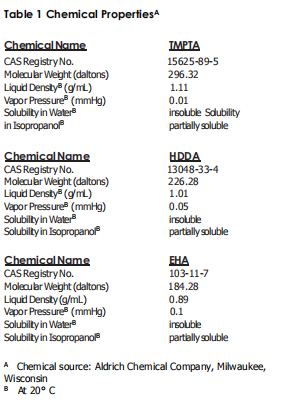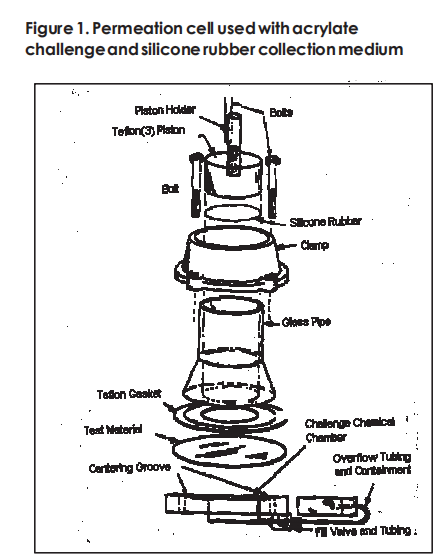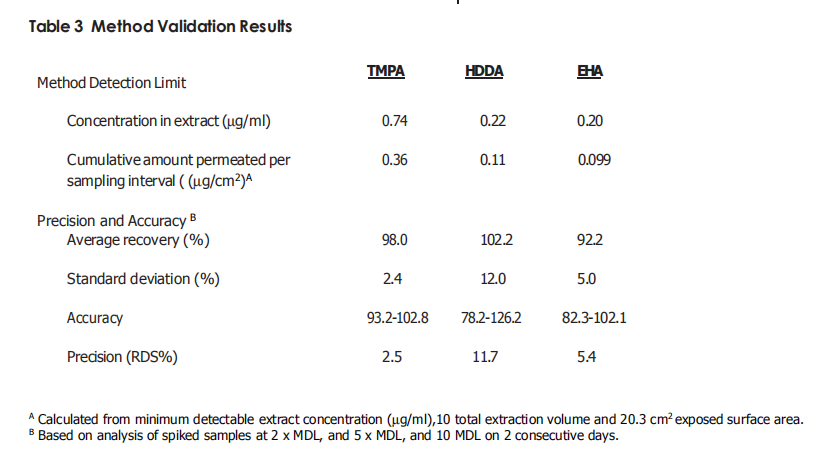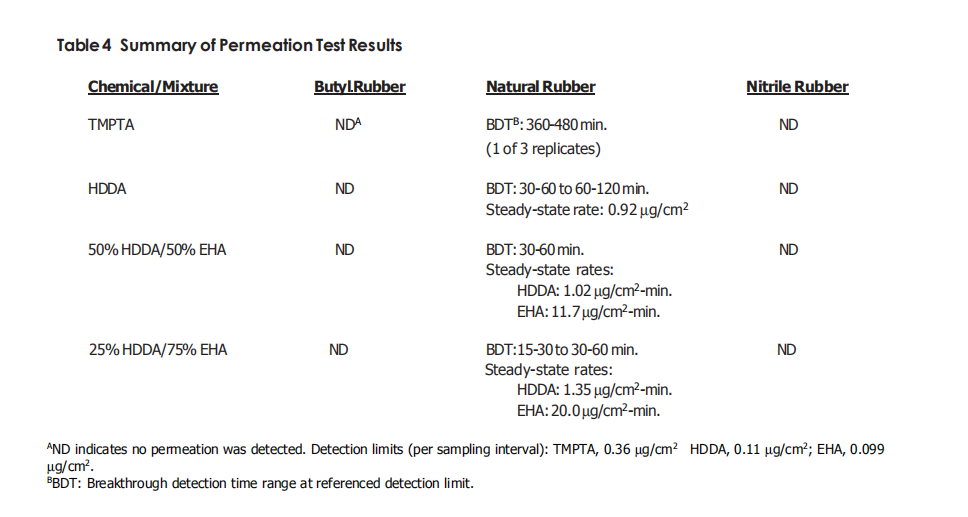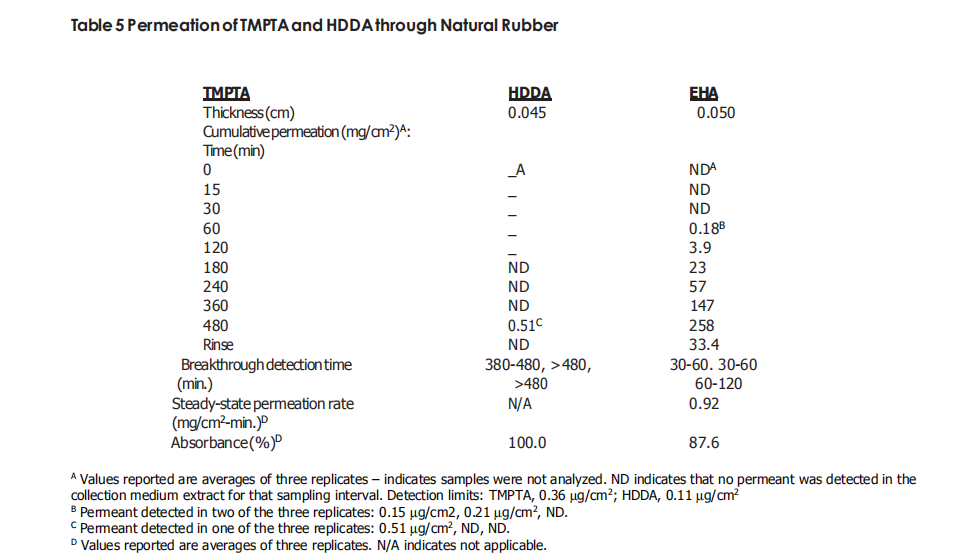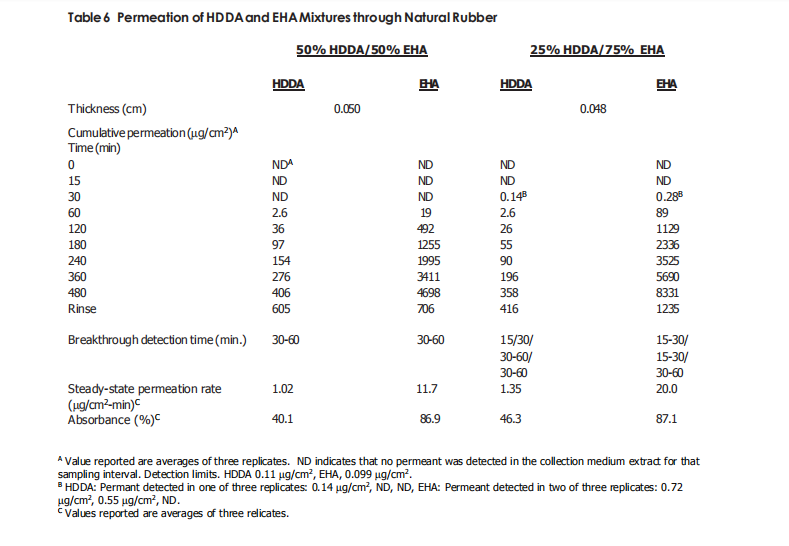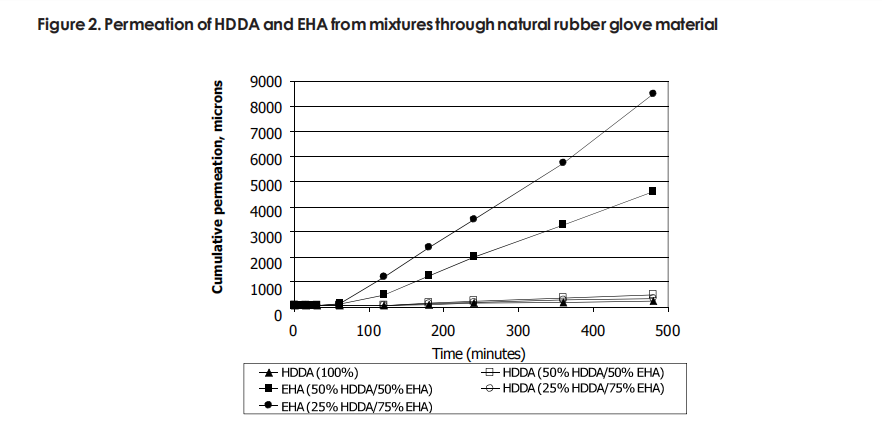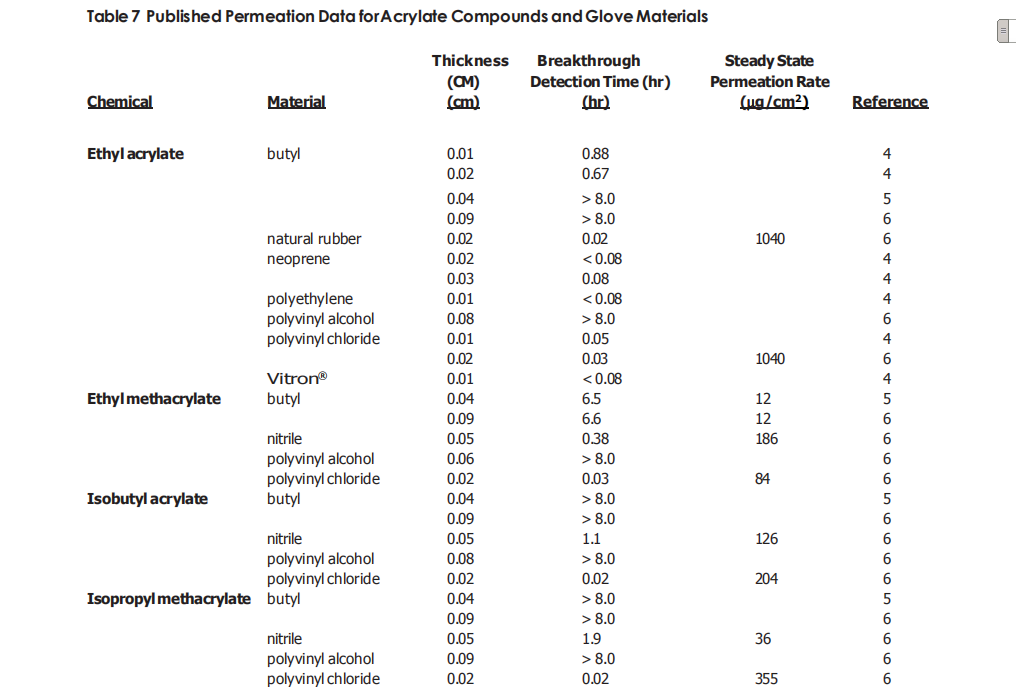Proper selection of protective gloves from a study of the permeability of different acrylate monomers
In support of the Environmental Protection Agency’s Office of Toxic Substances’ Pre-Production Notification (PMN) program, three glove materials were evaluated for their resistance to permeation by multifunctional acrylate compounds through a program of the Office of Research and Development. Several recent PMN reports have addressed multifunctional acrylates, and permeation data for such compounds are largely unavailable. To better understand the permeation behavior, tests were conducted with trimethylolpropane triacrylate (TMPTA), 1,6-hexanediol diacrylate (HDDA) and two mixtures of HDDA with isooctyl acrylate (EHA). Due to the low vapor pressure and low water solubility of these compounds, the tests were conducted using silicone rubber sheet material as the collection medium using ASTM method F739-85. Butyl rubber, natural rubber and nitrile rubber gloves were used as test materials at 20°C. No acrylate compounds or mixtures were found to penetrate butyl or nitrile rubber under the test conditions. Penetration of natural rubber was observed in tests with pure HDDA, 50% HDDA/50% EHA and 25% HDDA/75% EHA. Penetration through natural rubber was also detected for TMPTA, but was detected only once in three tests after 360-480 min sampling intervals. For pure HDDA, penetration was detected for 30-60 min at a steady-state penetration rate of 0.92 mg/cm~2-min. For HDDA/EHA blends, penetration of both blend components was detected at the same sampling interval for each test. penetration was detected for 30-60 min for 50/50 blends and for 25/75 blends for 15 -30 to 30-60 minutes. The steady-state penetration rates of HDDA were slightly higher for the blends than for pure HDDA, 1.02 mg/cm~2-min for the 50/50 blend and 1.35 mg/cm~2-min for the 25/75 blend. the slight increase in penetration rates was due to the presence of the more rapidly penetrating EHA carrier solvent, which penetrated at a rate of 11.7 mg/cm~2-min from the 50/50 blend and 11.7 mg/cm~ 2 -min and 20.0 mg/cm~2 -min from the 25/75 mixture.
Under Section 5 of the Toxic Substances Control Act (Public Law 94-469), a potential manufacturer or importer must submit a pre-production notification prior to the manufacture or importation of a new chemical. The Office of Toxic Substances (OTS) of the Environmental Protection Agency (EPA) reviews PMNs to assess the potential risks to human health that may result from dermal or inhalation exposure during the manufacture, processing, or end use of the chemical. the OTS must be able to evaluate the adequacy of protective clothing recommendations and supporting data provided by the PMN submitter in those cases where protective clothing is recommended as a means of minimizing dermal means of minimizing exposure. If the supporting data are inadequate, the OTS must be able to specify appropriate and reliable tests and be able to evaluate the resulting data.The OTS uses permeation data for PMN chemicals or similar compounds to evaluate the permeation resistance of protective clothing when used. However, PMN submitters are not required to provide data demonstrating acceptable penetration resistance.
Several recent PMN reports have addressed multifunctional acrylate compounds; however, a search of the literature and databases shows that permeation data for such compounds are largely unavailable. The limited published data on common acrylate compounds suggests that common glove materials have poor permeation resistance. In response to the OTS need for permeation data on four multifunctional acrylates, the Office of Research and Development, through its contractor Arthur D. Little, funded this study to examine representative acrylate compounds. However, conducting these permeation tests was not routine because of the solubility and physical properties of the compounds. Similar to many organophosphorus pesticides, multifunctional acrylates have low vapor pressure and low water solubility. Therefore, permeation tests must be conducted using collection media other than those specified in ASTM F739-Water or Inert Gases. Solid collection media silicone rubber sheets have been successfully used as an alternative collection medium to ASTM F739 (1-3) and are used here. Prior to the permeation tests, a method development task was conducted to determine the collection capacity and efficiency of silicone for acrylate compounds and to validate methods for extracting and quantifying the amount of acrylate collected.
Experimental materials and methods:
Materials:
The properties of two multifunctional acrylates were investigated using trimethylolpropane triacrylate (TMPTA) and 1,6-hexanediol diacrylate (HDDA) as raw materials. Two blends of HDDA with 2-ethylhexyl acrylate (EHA) were also tested: 50% HDDA/50% EHA and 25% HDDA/75% EHA, prepared as a percentage by volume. The properties of these compounds are shown in Table 1. penetration tests were performed with three protective glove materials: butyl rubber, natural rubber, and nitrile rubber. The description and source of these garment materials are shown in Table 2.
Instrument Description:
1. ASTM Method F739-85. “Standard Test Method for the Resistance of Protective Clothing Materials to Liquid or Gas Permeability” for solid collection media was modified.
2. The permeation cell was modified by replacing the standard collection chamber of the cell with a 7.62 cm (3 in.) long flanged section from a 5.08 cm (2 in.) ID glass tube, maintaining the standard 20.3 cm2 chemical contact area specified in ASTM F739. The “challenge side” of the test cell was changed to “test surface”? The challenge side was also modified to minimize the handling of large amounts of challenge chemicals. The standard challenge chamber was replaced with a stainless steel plate machined to hold 10 ml of challenge solution. The challenge chamber is connected via an overflow tube to a vial containing additional challenge solution to ensure continuous challenge and a closed system. A schematic diagram of the modified cell is shown in Figure 1.
2. The collection media was 0.051-cm (0.02-in.) silicone rubber sheet material (Silastic®), Dow Corning, Midland, Mich. In a previous EPA study, collection media for collecting low-volatility, low-water-soluble pesticides were evaluated and found to be more efficient at collecting permeable chemicals than the other media evaluated (1-3). A silicone rubber plate was cut to fit the glass tube ID and placed on the collection side of the glove material to be tested. A 2.54 cm (1 in.) long, tight-fitting Teflon® piston was placed on top of the silicone rubber collection plate of the glass tube to ensure good contact of the silicone rubber with the glove material and to minimize evaporation of the collected permeate.
Test Procedure:
The permeation test is performed in triplicate in a temperature and humidity controlled laboratory at 20°C. After assembling the glove material sample and silicone rubber disc in place, the test is started by charging the challenge chamber with acrylate. After a predetermined sampling interval, the silicone rubber disc is removed and replaced with a new disc. The sampling intervals were 0, 15, 30, 60, 180, 240, 360, and 480 min. These intervals were chosen to minimize the potential for saturation and swelling of the silicone rubber. After removal, each collection tray was transferred to a separate screw-cap vial and sonicated with 10 mL of ACS grade isopropanol for 20 min. An aliquot of the isopropanol extract was then analyzed to determine the concentration of the penetrant. From the concentration values, the penetration detection time and penetration rate of the chemical through the selected protective clothing material was determined.
Analytical Methods and Validation:
TMPTA, HDDA and EHA were quantified in the collected media extracts using gas chromatography with flame ionization detection (FID) (Hewlett-Packard Model 5890 gas chromatograph and J&W Scientific [Folsom, Calif.] 30-m DX4 capillary column). All calibration, validation, and QA/QC procedures were performed in accordance with established EPA guidelines and protocols.
Prior to permeation testing, analytical procedures were validated to determine the collection efficiency of the silicone rubber as well as the method detection limit (MDL), accuracy, and precision for the three acrylate compounds. To determine the MDL, seven replicates of the spiked silicone rubber matrix were analyzed at or near the estimated detection limit. The process of applying a known amount of acrylate compound to a defined surface area of silicone rubber to nail down the silicone rubber. The standard deviations of the concentration values of the seven spiked samples were used to calculate the MDL. the precision and accuracy of the analytical method was established by analyzing four different concentrations of spiked silicone rubber samples (2 x MDL, 5 x MDL and 10 x MDL). These samples were analyzed on two consecutive days. The mean recovery (P), standard deviation of the mean recovery (Sp) and relative standard deviation (RSD) were calculated based on the results of spiked silica gel. The accuracy of the method was defined as the recovery interval from P-2Sp. to P+2Sp. The accuracy of the method was evaluated by RDS. The validation results are summarized in Table 3, and these results are consistent with the quality assurance objectives established for the laboratory program.
Quality assurance and control procedures include routine analysis of calibration standards and analysis of spiked silicone standards for duplicate samples. The measurement of permeation “absorbance” is the ratio of the mass of chemical absorbed by the silicone rubber to the total mass of chemical that permeates the clothing material in each permeation test. At the end of the 360-480 min. sampling cycle, the collection media side of the clothing material sample is rinsed with frozen isopropyl alcohol and the rinse solution is analyzed for permeability. The absorbance was calculated as follows.
The compounds detected in the rinse solution may represent compounds available on the surface of the clothing material or compounds extracted from that material. The average absorbance target value of the permeate was >80% with a coefficient of variation of +20%.
Results:
The results of the permeation tests, summarized in Table 4, indicate that no acrylate compounds or mixtures were detected to permeate the butyl rubber or nitrile rubber materials within 480 minutes. Penetration of each excitation compound or mixture through the natural rubber material was detected, and these results are discussed on the next page.
TMPTA Monomer
TMPTA penetration was not detected in the tests with butyl rubber and nitrile rubber materials. The results of the TMPTA permeation test with natural rubber (see Table 5) indicate that TMPTA permeation was detected in one of the three replicate tests for samples from 360-480 min. At the end of the permeation test, TMPTA was not detected in any of the isopropanol rinses of the natural rubber samples (i.e., absorbance was equal to 100%).
HDDA Monomer
No penetration of HDDA was detected in tests performed with butyl and nitrile rubber materials. The results of permeation testing of natural rubber with pure HDDA are also shown in Table 5 In two replicates, HDDA was first detected in samples from 30-60 min. in the third replicate, HDDA was first detected in samples from 60-120 min. in subsequent samples, cumulative permeation increased and approached a linear permeation rate of 360-480 min. Sample interval. The slope of the cumulative permeation curve from 240-360 min to 360-480 min samples were used to calculate the average steady-state permeation rate of 0.92 μg/cm2 -min. As shown in Table 5, the average absorbance HDDA was 87.6%, indicating that the amount of HDDA found in the isopropanol rinse of the natural rubber samples was small relative to the amount collected during the permeation test. The high absorbance seems to further confirm the suitability of silicone rubber as an HDDA collection medium.
Blends of HDDA and EHA
No penetration of HDDA or EHA in the blends was detected in tests conducted with butyl and NBR materials. Results of permeation tests with natural rubber and NBR materials. The results of the natural rubber permeation tests are summarized in Table 6. The results show that for the 50% HDA/50% EHA blends, penetration of HDDA and EHA was first detected at 30-60 minutes. sampling interval in all three replicates. Both permeates reached steady-state permeation rates after 120-180 min. the permeation rate of EHA was much higher than that of HDDA in the mixture: 11.7 mg/cm2-min. vs. 1.02 mg/cm2-min. the permeation rate of HDDA from the 50% mixture was essentially equal to that in the pure HDDA experiment. Thus, the decrease in HDDA concentration does not appear to affect the permeation rate. However, it is important to note that the absorbance values of HDDA in these experiments were very low, averaging only 40.1%. This value is low compared to the average value of 86.9% for the absorbance of EHA8 in the same tests and the average value of 87.6% in the pure HDDA permeation tests. A slight wrinkling of the natural rubber material was noted after 15-30 minutes. It is possible that this wrinkling prevented the natural rubber from coming into close contact with the silicone rubber collection medium, resulting in a lower absorbance of HDDA with a low vapor pressure relative to EHA. The higher absorbance may be caused by the higher permeability of HDDA in the mixture. Similar results were found in the permeation tests of the 25% HDDA/75% EHA mixture and the natural rubber material.
As shown in Table 6, penetration of HDDA and EHA was first detected in the 15-30 min samples. As shown in Figure 2, the penetration of HDDA from the mixture (and the 50% mixture) was similar to that measured for pure HDDA, although slightly higher. The slight increase in HDDA permeation rate in the mixture relative to pure HDDA may be due to the presence of a more rapidly permeating EHA carrier solvent. In contrast, the EHA permeation rate of the 25% HDDA/75% EHA mixture was much higher than the EHA permeation rate of the 50% HDDA/50% EHA mixture. the EHA permeation rate was strongly dependent on its concentration in the mixture; however, the authors did not perform experiments with pure EHA, so a quantitative comparison was not possible.
Discussion
Under test conditions, butyl rubber and nitrile materials showed greater penetration resistance to TMPTA, HDDA and EHA than natural rubber. Other than these results, there are few reports in the literature of protective clothing permeation data for multifunctional acrylate compounds. Permeation data have been generated for several simple acrylate compounds and are summarized in Table 7. Additional findings for multifunctional acrylate compounds have not been confirmed. (3) A comparison of these data with those obtained in this study indicates that multifunctional acrylates penetrate natural rubber at a lower rate than single acrylate compounds. Therefore, unless a larger data set covering the range of chemical complexity in the chemical classification of acrylates is generated, it is difficult to predict the penetration of larger, more complex multifunctional compounds based on the results of penetration tests of common acrylate compounds.
Under the same test conditions and test methods, butyl and nitrile rubber materials were more effective than natural rubber in blocking the penetration of multifunctional acrylate compounds. Comparing these results with those reported by other researchers, it was found that the rate of penetration of multifunctional acrylates into the glove material (in this case, natural rubber) was much lower than the rate of penetration of simple acrylate compounds.
Conclusion
The permeability of multifunctional acrylates and their mixtures can be successfully determined by ASTM F739 permeation method using silicone rubber collection media. The silicone rubber membrane is suitable as a collection medium for TMPTA, HDDA and EHA. In general, the collection capacity and efficiency are good; however, the uptake of HDDA is low in the permeation test of HDDA and EHA mixtures. The use of silicone rubber collection media is not recommended to test the permeability of significantly swollen or wrinkled protective clothing.
UV Photoinitiator Same series products
| Product name | CAS NO. | Chemical name |
| Sinocure® TPO | 75980-60-8 | Diphenyl(2,4,6-trimethylbenzoyl)phosphine oxide |
| Sinocure® TPO-L | 84434-11-7 | Ethyl (2,4,6-trimethylbenzoyl) phenylphosphinate |
| Sinocure® 819/920 | 162881-26-7 | Phenylbis(2,4,6-trimethylbenzoyl)phosphine oxide |
| Sinocure® 819 DW | 162881-26-7 | Irgacure 819 DW |
| Sinocure® ITX | 5495-84-1 | 2-Isopropylthioxanthone |
| Sinocure® DETX | 82799-44-8 | 2,4-Diethyl-9H-thioxanthen-9-one |
| Sinocure® BDK/651 | 24650-42-8 | 2,2-Dimethoxy-2-phenylacetophenone |
| Sinocure® 907 | 71868-10-5 | 2-Methyl-4′-(methylthio)-2-morpholinopropiophenone |
| Sinocure® 184 | 947-19-3 | 1-Hydroxycyclohexyl phenyl ketone |
| Sinocure® MBF | 15206-55-0 | Methyl benzoylformate |
| Sinocure® 150 | 163702-01-0 | Benzene, (1-methylethenyl)-, homopolymer,ar-(2-hydroxy-2-methyl-1-oxopropyl) derivs |
| Sinocure® 160 | 71868-15-0 | Difunctional alpha hydroxy ketone |
| Sinocure® 1173 | 7473-98-5 | 2-Hydroxy-2-methylpropiophenone |
| Sinocure® EMK | 90-93-7 | 4,4′-Bis(diethylamino) benzophenone |
| Sinocure® PBZ | 2128-93-0 | 4-Benzoylbiphenyl |
| Sinocure® OMBB/MBB | 606-28-0 | Methyl 2-benzoylbenzoate |
| Sinocure® 784/FMT | 125051-32-3 | BIS(2,6-DIFLUORO-3-(1-HYDROPYRROL-1-YL)PHENYL)TITANOCENE |
| Sinocure® BP | 119-61-9 | Benzophenone |
| Sinocure® 754 | 211510-16-6 | Benzeneacetic acid, alpha-oxo-, Oxydi-2,1-ethanediyl ester |
| Sinocure® CBP | 134-85-0 | 4-Chlorobenzophenone |
| Sinocure® MBP | 134-84-9 | 4-Methylbenzophenone |
| Sinocure® EHA | 21245-02-3 | 2-Ethylhexyl 4-dimethylaminobenzoate |
| Sinocure® DMB | 2208-05-1 | 2-(Dimethylamino)ethyl benzoate |
| Sinocure® EDB | 10287-53-3 | Ethyl 4-dimethylaminobenzoate |
| Sinocure® 250 | 344562-80-7 | (4-Methylphenyl) [4-(2-methylpropyl)phenyl] iodoniumhexafluorophosphate |
| Sinocure® 369 | 119313-12-1 | 2-Benzyl-2-(dimethylamino)-4′-morpholinobutyrophenone |
| Sinocure® 379 | 119344-86-4 | 1-Butanone, 2-(dimethylamino)-2-(4-methylphenyl)methyl-1-4-(4-morpholinyl)phenyl- |
| Sinocure® 938 | 61358-25-6 | Bis(4-tert-butylphenyl)iodonium hexafluorophosphate |
| Sinocure® 6992 MX | 75482-18-7 & 74227-35-3 | Cationic Photoinitiator UVI-6992 |
| Sinocure® 6992 | 68156-13-8 | Diphenyl(4-phenylthio)phenylsufonium hexafluorophosphate |
| Sinocure® 6993-S | 71449-78-0 & 89452-37-9 | Mixed type triarylsulfonium hexafluoroantimonate salts |
| Sinocure® 6993-P | 71449-78-0 | 4-Thiophenyl phenyl diphenyl sulfonium hexafluoroantimonate |
| Sinocure® 1206 | Photoinitiator APi-1206 |

